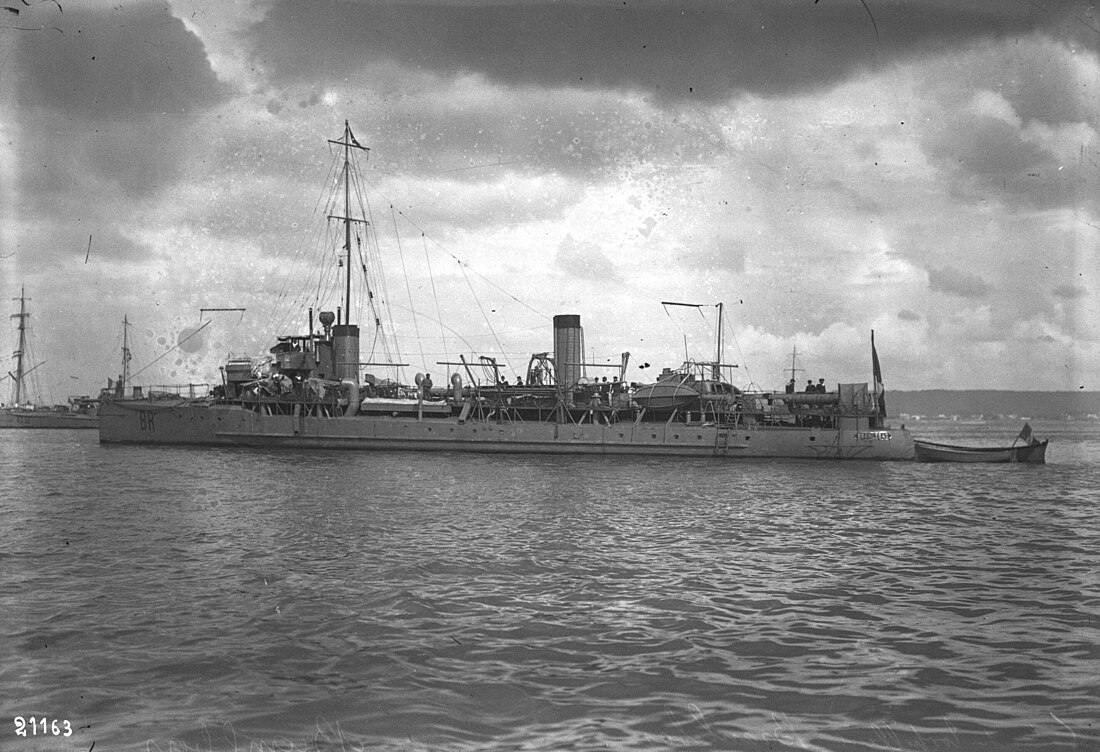Branlebas was the name ship of her class of destroyers built for the French Navy in the first decade of the 20th century.
 Branlebas in harbor | |
| History | |
|---|---|
| Name | Branlebas |
| Namesake | Action stations |
| Builder | Chantiers et Ateliers Augustin Normand, Le Havre |
| Laid down | November 1905 |
| Launched | 8 October 1907 |
| Fate | Sunk 30 September 1915 |
| General characteristics | |
| Class and type | Branlebas-class destroyer |
| Displacement | 350 t (344 long tons) |
| Length | 58 m (190 ft 3 in) (p/p) |
| Beam | 6.28 m (20 ft 7 in) |
| Draft | 2.96 m (9 ft 9 in) |
| Installed power |
|
| Propulsion | 2 shafts; 2 Triple-expansion steam engines |
| Speed | 27.5 knots (50.9 km/h; 31.6 mph) |
| Range | 2,100 nmi (3,900 km; 2,400 mi) at 10 knots (19 km/h; 12 mph) |
| Complement | 60 |
| Armament |
|
| Armor | Waterline belt: 20 mm (0.8 in) |
During World War I, Branlebas struck a mine and sank in the North Sea between Dunkirk, France, and Nieuwpoort, Belgium, on 30 September 1915.[1]
Design
The Branlebas-class was a development of the previous Claymore class, and was the final evolution of the 300-tonne type which the French had built since 1899, with their first destroyer class, the Durandal-class. Like all the 300-tonne destroyers, the Branlebas class had a turtledeck forecastle with a flying deck, raised above the hull, aft.[2]
They were 58 metres (190 ft 3 in) long between perpendiculars and 59.06 m (193 ft 9 in) overall,[3][4] with a beam of 6.28 metres (20 ft 7 in) and a maximum draught of 2.37 metres (7 ft 9 in). Displacement was 350 tonnes (344 long tons). Two coal-fired Normand or Du Temple boilers fed steam to two triple-expansion steam engines, rated at 6,800 indicated horsepower (5,100 kW), and driving two propeller shafts, giving a design speed of 27.5 knots (50.9 km/h; 31.6 mph). The ships had a range of 2,100 nautical miles (3,900 km; 2,400 mi) at 10 knots (19 km/h; 12 mph).[3]
A 20 millimetres (0.79 in) belt of armour was fitted to protect the ship's boilers and machinery from splinters.[2][5] The class was built with the standard gun armament for the 300-tonne destroyers, with a single 65 mm (2.6 in) forward, backed up by six 47 mm (1.9 in) guns, while two 450 mm (17.7 in) torpedo tubes were carried.[2] The ships had a complement of 4 officers and 56 men.[3]
Construction and service
Branlebas was laid down at the Le Havre shipyard of Chantiers et Ateliers A. Normand in November 1905 and was launched on 8 October 1910. She reached a speed of 28.76 kn (33.10 mph; 53.26 km/h) during sea trials.[5]
When the First World War began in August 1914, Branlebas was assigned to the 1st Destroyer Flotilla (1re escadrille de torpilleurs) of the 2nd Light Squadron (2e escadre légère)[6] based at Cherbourg.
References
Bibliography
Wikiwand in your browser!
Seamless Wikipedia browsing. On steroids.
Every time you click a link to Wikipedia, Wiktionary or Wikiquote in your browser's search results, it will show the modern Wikiwand interface.
Wikiwand extension is a five stars, simple, with minimum permission required to keep your browsing private, safe and transparent.
